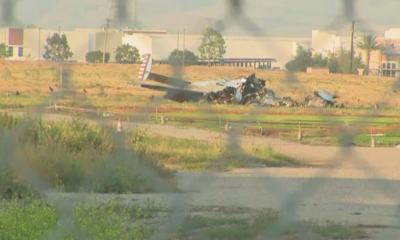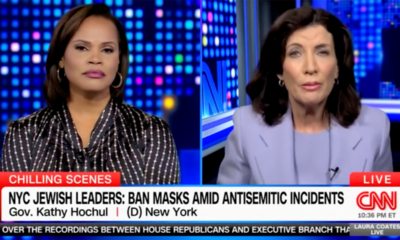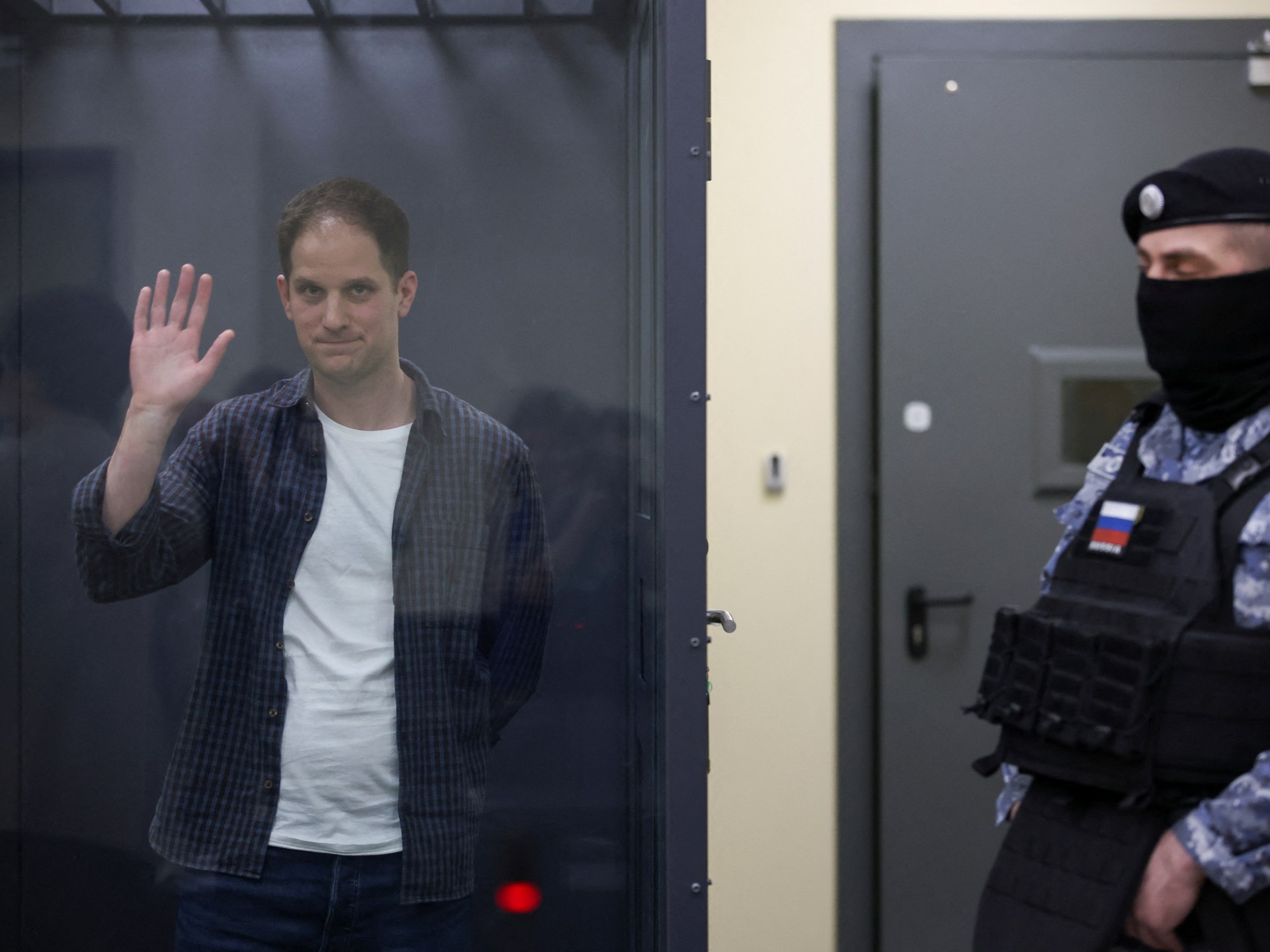New York
Supporters of Aid in Dying Sue N.J. Over Residency Requirement

Judy Govatos has heard that magical phrase “you’re in remission” twice, in 2015 and again in 2019. She had beaten back Stage 4 lymphoma with such aggressive chemotherapy and other treatments that at one point she grew too weak to stand, and relied on a wheelchair. She endured several hospitalizations, suffered infections and lost nearly 20 pounds. But she prevailed.
Ms. Govatos, 79, a retired executive at nonprofit organizations who lives in Wilmington, Del., has been grateful for the extra years. “I feel incredibly fortunate,” she said. She has been able to take and teach lifelong learning courses, to work in her garden, to visit London and Cape Cod with friends. She spends time with her two grandchildren, “an elixir.”
But she knows that the cancer may well return, and she doesn’t want to endure the pain and disability of further attempts to vanquish it.
“I’m not looking to be treated to death. I want quality of life,” she told her oncologist. “If that means less time alive, that’s OK.” When her months dwindle, she wants medical aid in dying. After a series of requests and consultations, a doctor would prescribe a lethal dose of a medication that she would take on her own.
Aid in dying remains illegal in Delaware, despite repeated legislative attempts to pass a bill permitting it. Since 2019, however, it has been legal in neighboring New Jersey, a half-hour drive from Ms. Govatos’s home.
But New Jersey restricts aid in dying to terminally ill residents of its own state. Ms. Govatos was more than willing, therefore, to become one of four plaintiffs — two patients, two doctors — taking New Jersey officials to federal court.
The lawsuit, filed last month, argues that New Jersey’s residency requirement violates the Constitution’s privileges and immunities clause and its equal protection clause.
“The statute prohibits New Jersey physicians from providing equal care to their non-New Jersey resident patients,” said David Bassett, a lawyer with the New York firm Wilmer Cutler Pickering Hale and Dorr, which brought the suit with the advocacy group Compassion & Choices.
“There’s no justification that anyone has articulated” for such discrimination, he added. The suit also contends that forbidding New Jersey doctors to offer aid-in-dying care to out-of-state patients restricts interstate commerce, the province of Congress.
The New Jersey Attorney General’s office declined to comment.
“I’d like not to die in horrible pain and horrible fear, and I’ve experienced both,” Ms. Govatos said. Even if she enrolls in hospice, many of the pain medications used cause her to pass out, hallucinate and vomit.
To be able to legally end her life when she decides to “is a question of mercy and kindness,” she said.
It’s the third time that Compassion & Choices has pursued this route in its efforts to broaden access to aid in dying. It filed similar suits in Oregon in 2021 and in Vermont last year. Both states agreed to settle, and their legislatures passed revised statutes repealing residency requirements, Oregon in July and Vermont in May.
The plaintiffs hope New Jersey, another blue state, will follow suit. “We hope we never have to go before a judge. Our preference is to negotiate an equitable resolution,” Mr. Bassett said. “That’s what’s important for our patient plaintiffs. They don’t have time for full-fledged litigation.”
“It’s not the traditional process of trying to convince a state legislature that this is a good idea,” said Thaddeus Pope, a law professor at Mitchell-Hamline School of Law in St. Paul, Minn., who tracks end-of-life laws and court cases.
Dropping residency requirements in New Jersey could have a far greater impact than it will in Oregon or Vermont. The sheer population density along New Jersey’s borders — there are almost 20 million residents in the New York metropolitan area alone — means medical aid in dying would suddenly become available to vastly more people, and much more quickly than it would through legislation.
With a major airport and direct flights, “it’s easier to get to Newark than Burlington, Vermont,” Mr. Pope pointed out.
Many states where aid in dying is legal have relaxed their statutes because of findings like those in a 2017 study, in which about a third of California patients who asked a doctor about aid in dying either died before they could complete the process or became too ill to continue it.
But New Jersey still uses the stricter series of steps that Oregon first codified in 1994. That means two verbal requests to a doctor at least 15 days apart, a written request with two witnesses, and a consultation with a second physician; both must confirm that the patient is eligible. There’s a 48-hour wait after the written request before a prescription can be written.
Even without having to establish residency, “it won’t be a walk in the park,” Mr. Pope said. “You can’t just pop over to New Jersey, pick up the drugs and go back.”
Finding a doctor willing to prescribe can take time, as does using one of the state’s few compounding pharmacies, which combine the necessary drugs and fill the prescription.
Although no official would check to see whether patients travel home with the medication, both Mr. Bassett and Mr. Pope advise that the lethal dose ought to be taken in New Jersey, to avoid the possibility of family members facing prosecution in their home states for assisting in a suicide.
Still, preventing dying patients from having to sign leases and obtain government IDs in order to become residents will streamline the process. “Not everyone has the will, the financial means, the physical means” to establish residency, said Dr. Paul Bryman, one of the doctor plaintiffs and hospice medical director in southern New Jersey. “These are often very disabled people.”
Bills recently introduced in Minnesota and New York don’t include residency requirements at all, Mr. Pope noted, since they seem likely to be challenged in court.
“I think the writing’s on the wall,” he said. “I think all the residency requirements will go, in all the states” where aid in dying is legal. There are 10, plus the District of Columbia (though the legality in Montana depends on a court decision, not legislation).
Despite the often heated wrangling over aid-in-dying laws, very few patients actually turn to lethal drugs in the end, state records show. Last year, Oregon reported that 431 people received prescriptions and 278 died by using them, just .6 percent of the state’s deaths in 2022.
In New Jersey, only 91 patients used aid in dying last year. Roughly a third of those who receive prescriptions never use them, perhaps sufficiently reassured by the prospect of a swift exit.
Fears of “death tourism,” with an onrush of out-of state patients, have not materialized, said John Burzichelli, a former state assemblyman who helped steer New Jersey’s statute through the legislature and now favors allowing eligible nonresidents to participate.
“I don’t see lines of people at the tollbooths coming to take advantage of this law,” he said.
If her cancer returns and New Jersey has balked at allowing out-of-staters to legally end their lives there, Ms. Govatos contemplates traveling to Vermont. She envisions a goodbye party for a few friends and family members, with poetry reading, music and “very good wine and lovely food.”
But driving over the Delaware Memorial Bridge would be so much simpler. “It would be an incredible gift if I could go to New Jersey,” she said.

New York
Transcript of Trump Manhattan Trial, May 30, 2024

-
Jury Deliberation Re-charge
SUPREME COURT OF THE STATE OF NEW YORK
COUNTY OF NEW YORK CRIMINAL TERM
-
-
PART: 59
Χ
THE PEOPLE OF THE STATE OF NEW YORK,
-against-
DONALD J. TRUMP,
DEFENDANT.
BEFORE:
Indict. No.
71543-2023
CHARGE
4909
FALSIFYING BUSINESS
RECORDS 1ST DEGREE
JURY TRIAL
100 Centre Street
New York, New York 10013
May 30, 2024
HONORABLE JUAN M. MERCHAN
JUSTICE OF THE SUPREME COURT
APPEARANCES:
FOR THE PEOPLE:
ALVIN BRAGG, JR., ESQ.
DISTRICT ATTORNEY, NEW YORK COUNTY
One Hogan Place
New York, New York 10013
BY:
JOSHUA STEINGLASS, ESQ.
MATTHEW COLANGELO,
ESQ.
SUSAN HOFFINGER, ESQ.
CHRISTOPHER CONROY, ESQ.
BECKY MANGOLD, ESQ.
KATHERINE ELLIS, ESQ.
Assistant District Attorneys
BLANCHE LAW
BY:
TODD BLANCHE, ESQ.
EMIL BOVE, ESQ.
KENDRA WHARTON, ESQ.
NECHELES LAW, LLP
BY: SUSAN NECHELES, ESQ.
GEDALIA STERN, ESQ.
Attorneys for the Defendant
SUSAN PEARCE-BATES, RPR, CSR, RSA
Principal Court Reporter
LAURIE EISENBERG, RPR, CSR
LISA KRAMSKY
THERESA MAGNICCARI
Senior Court Reporters
Susan Pearce-Bates, RPR, CCR, RSA
Principal Court Reporter
New York
Transcript of Trump Manhattan Trial, May 29, 2024

SUPREME COURT OF THE STATE OF NEW YORK
COUNTY OF NEW YORK CRIMINAL TERM
-
THE PEOPLE OF THE STATE OF NEW YORK,
PART: 59
Indict. No.
71543-2023
CHARGE
-against-
DONALD J. TRUMP,
DEFENDANT.
BEFORE:
4815
FALSIFYING BUSINESS
RECORDS 1ST DEGREE
JURY TRIAL
X
100 Centre Street
New York, New York 10013
May 29, 2024
HONORABLE JUAN M. MERCHAN
JUSTICE OF THE SUPREME COURT
APPEARANCES:
FOR THE
PEOPLE:
ALVIN BRAGG, JR.,
ESQ.
DISTRICT ATTORNEY, NEW YORK COUNTY
One Hogan Place
New York, New York 10013
BY:
JOSHUA STEINGLASS, ESQ.
MATTHEW COLANGELO,
ESQ.
SUSAN HOFFINGER, ESQ.
CHRISTOPHER CONROY, ESQ.
BECKY MANGOLD, ESQ.
KATHERINE ELLIS, ESQ.
Assistant District Attorneys
BLANCHE LAW
BY:
TODD BLANCHE, ESQ.
EMIL BOVE, ESQ.
KENDRA WHARTON, ESQ.
NECHELES LAW, LLP
BY: SUSAN NECHELES, ESQ.
Attorneys for the Defendant
SUSAN PEARCE-BATES, RPR, CSR, RSA
Principal Court Reporter
LAURIE EISENBERG, RPR, CSR
LISA KRAMSKY
THERESA MAGNICCARI
Senior Court Reporters
Susan Pearce-Bates,
RPR, CCR, RSA
Principal Court Reporter
New York
Critics Fault ‘Aggressive’ N.Y.P.D. Response to Pro-Palestinian Rally

Violent confrontations at a pro-Palestinian rally in Bay Ridge, Brooklyn, on Saturday reflected what some local officials and protest organizers called an unexpectedly aggressive Police Department response, with officers flooding the neighborhood and using force against protesters.
At the rally, which drew hundreds of demonstrators, at least two officers wearing the white shirts of commanders were filmed punching three protesters who were prone in the middle of a crosswalk. One officer had pinned a man to the ground and repeatedly punched him in the ribs, a 50-second video clip shows. Another officer punched the left side of a man’s face as he held his head to the asphalt.
The police arrested around 40 people who were “unlawfully blocking roadways,” Kaz Daughtry, the department’s deputy commissioner of operations, said on social media on Sunday.
Mr. Daughtry shared drone footage of one person who climbed on a city bus, “putting himself and others in danger.” The Police Department, he wrote, “proudly protects everyone’s right to protest, but lawlessness will never be tolerated.”
Neither Mr. Daughtry nor the police commented on the use of force by officers. A spokeswoman for Mayor Eric Adams did not immediately respond to a request for comment about the police response. The Police Department’s patrol guide states that officers must use “only the reasonable force necessary to gain control or custody of a subject.”
Bay Ridge has a significant Arab American population and hosts demonstrations in mid-May every year to commemorate what Palestinians call the Nakba, or “catastrophe” — when hundreds of thousands of Palestinians fled or were forced from their homes during the war that led to Israel’s founding in 1948.
Andrew Gounardes, a state senator and a Democrat who represents the area, said local politicians had been in touch with the commanding officer of the 68th police precinct before the preplanned protest and said there had been no indication that there would be such a heavy police response. He called the videos he saw of the events “deeply concerning.”
“It certainly seems like the police came ready for a much more aggressive and a much more confrontational demonstration than perhaps they had gotten,” he added.
Justin Brannan, a Democrat who is the city councilman for the area, said the protest was smaller than last year’s but that officers had come from all over the city to police it. He said their approach appeared to be directed by 1 Police Plaza, the department headquarters in Manhattan.
“These were not our local cops. Clearly, there was a zero-tolerance edict sent down from 1PP, which escalated everything and made it worse,” Mr. Brannan said.
“I’m still waiting on information and details about the arrests that were made,” he added, “but from my vantage point, the response appeared pre-emptive, retaliatory and cumulatively aggressive.”
The Republican state assemblyman whose district includes parts of Bay Ridge, Alec Brook-Krasny, had a different perspective. He said an investigation would determine whether the officers’ actions were warranted, but he said some protesters were “breaking the law” by refusing to clear the street.
“I think that those bad apples are really hurting the ability of the other people to express their opinions,” Mr. Brook-Krasny said.
Some local residents supported the police and said they were tired of the protests’ disruptive impact. “Enough is enough,” said Peter Cheris, 52, a 40-year resident of Bay Ridge, who said he had viewed the videos of the protest. “If you’re going to break the law, you deserve it,” he said.
Donna Lieberman, the executive director of the New York Civil Liberties Union, singled out the presence of the Police Department’s Strategic Response Group, a unit that is sometimes deployed to protests and has been the subject of several lawsuits brought by the civil liberties union and other groups.
The police unit’s handling of the demonstration “was a violation of New Yorkers’ right to speak out and risks chilling political expression,” Ms. Lieberman said in a statement. “N.Y.C.L.U. protest monitors witnessed violent arrests, protester injuries, and even arrests of credentialed members of the press.”
She added: “The continual pattern of N.Y.P.D. aggression against pro-Palestine demonstrators raises important questions about the city’s disparate treatment of speakers based on their message.”
Abdullah Akl, an organizer with Within Our Lifetime, the pro-Palestinian group that organized the protests, said the response took organizers aback, particularly for a demonstration that occurs every year in Bay Ridge and is known to be frequented by families with children.
“It was really an unusual and unprecedented response,” Mr. Akl said.
He said he witnessed two men being pushed to the ground. One of them can be seen in a video with blood streaming down the side of his face. Nerdeen Kiswani, chair of Within Our Lifetime, said three protesters — including the two who can be seen being punched — were treated for their injuries at hospitals.
The Police Department has arrested hundreds of demonstrators since street protests began shortly after the Hamas attack on Israel on Oct. 7 and Israel’s subsequent invasion of Gaza. The protests have been largely peaceful, with few injuries or violent clashes.
In a turning point, on April 30 officers cleared Hamilton Hall at Columbia University, which had been occupied by protesters for 17 hours. Many officers showed restraint during the arrests, though a handful were filmed pushing and dragging students as they removed them from the building.
On Sunday, Ms. Lieberman said police response to the protests in Bay Ridge underscored the importance of implementing the terms of a $512,000 settlement the civil liberties union and the Legal Aid Society reached with the city this month. The settlement set new terms for how the Police Department manages protests, creating a tiered system that dictates how many officers can be sent to demonstrations and limits the use of the Strategic Response Group. It will take years to put into practice.
The settlement is one of several that stemmed from the George Floyd racial justice protests in 2020. Last year, the city agreed to pay $13.7 million to settle a class-action lawsuit that claimed unlawful police tactics had violated the rights of demonstrators in Manhattan and Brooklyn. In March, the city agreed to pay $21,500 to each of roughly 300 people who attended another Black Lives Matter protest in 2020 in the Bronx. Those people were penned in by the police, then charged at or beaten with batons, according to a legal settlement.
Andy Newman and Camille Baker contributed reporting.
-

 News1 week ago
News1 week agoRead Justice Clarence Thomas’s Financial Disclosures for 2023
-

 Politics1 week ago
Politics1 week agoNewson, Dem leaders try to negotiate Prop 47 reform off California ballots, as GOP wants to let voters decide
-

 World1 week ago
World1 week ago‘Bloody policies’: Bodies of 11 refugees and migrants recovered off Libya
-

 Politics1 week ago
Politics1 week agoGun group vows to 'defend' Trump's concealed carry license after conviction
-

 Politics1 week ago
Politics1 week agoShould Trump have confidence in his lawyers? Legal experts weigh in
-

 Politics6 days ago
Politics6 days agoGOP releases Jan. 6 clip of Pelosi saying 'I take responsibility' as she discussed National Guard absence
-

 Movie Reviews1 week ago
Movie Reviews1 week ago‘Darkest Miriam’ Review: Britt Lower in a Marvel of a Drama About a Young Librarian’s Loves and Fears
-

 World1 week ago
World1 week agoOrban party loses major support in Hungary's EU election

















